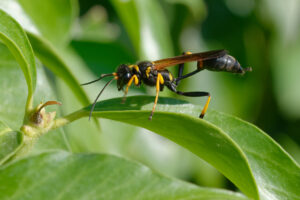Dogwood Canyon Blog
What’s the Buzz on Unusual Pollinators?
June 19, 2024

What do wasps, mosquitos, and flies have in common? They are all considered unusual pollinators! Birds, butterflies, and bees are most commonly thought of as pollinators, but there are many insects and animals that play a role in pollination.
Mosquitos – for example – are not trying to make a meal out of you. Females harvest blood for their young, but they turn to flowers for their nectar as a main food source; male mosquitos rely solely on flower nectar as it is their primary food source. Just like honeybees and bumblebees, pollen sticks to their bodies and falls off as they travel from flower to flower to help fertilize plants.

Behind the honeybee, can you guess what the second most important pollinator is? Here’s a hint – it’s not a bee. Like mosquitos, flies are often viewed as pesky insects, but they are regarded as the second most essential pollinator! The Center for Pollinator Research explains how flies inhabit colder climate regions where there are fewer bees. In alpine and subarctic environments, flies help to pollinate these areas by using their hairy bodies to trap pollen as they move. Feeding on the nectar of flowers, they snack as they pollinate – a win-win!
On the larger side, bats help with seed dispersal and assist in the pollination of fruit, flowers, and other crops. A single Mexican long-nose bat is a great example and will visit up to 30 flowers each night. These flying mammals – though rarely seen due to their nocturnal habits – are as essential to their environment as the diurnal birds, bees, and even wasps.

Mud daubers are one of the seven wasp subspecies in Missouri and are increasingly important to the pollination process because of the general decline of bee populations worldwide. Like other insects mentioned, adult wasps feed on flower nectar which gives them energy to fuel their flight endeavors. Without the help of wasps and other unusual pollinators, honeybees and bumblebees would solely carry the weight of pollination.


Fun Fact! Dogwood Canyon is home to many mud daubers. The nests of the pipe organ mud dauber can be seen decorating the walls of Great Spirit Rock Shelter. If you get the chance to see these nests, you will notice how their construction resembles an organ or a pan flute.
Pollinators of all shapes and sizes are crucial to the health of ecosystems. Their teamwork helps to provide a variety of food sources and shelter for all living creatures, and plants help stabilize the soil, clean the air, supply oxygen, and support wildlife. According to the National Institute of Food and Agriculture, scientists estimate about 75% of the world’s flowering plants and 35% of the world’s food crops depend on pollinators to produce.
To help these creatures in their pollination endeavors, consider leaving fallen logs or stumps for bees, beetles, and flies to use for nesting. Leave out a dish of water on your deck for thirsty pollinators to stay hydrated. Place a stone in the dish to give them a place to land and avoid the risk of drowning. If you have a garden, try planting a variety of flowers in clumps rather than scattering single flowers throughout. Regardless of which method you choose to help, know that pollinators – both usual and unusual – are extraordinary and a key part of every ecosystem’s success.
